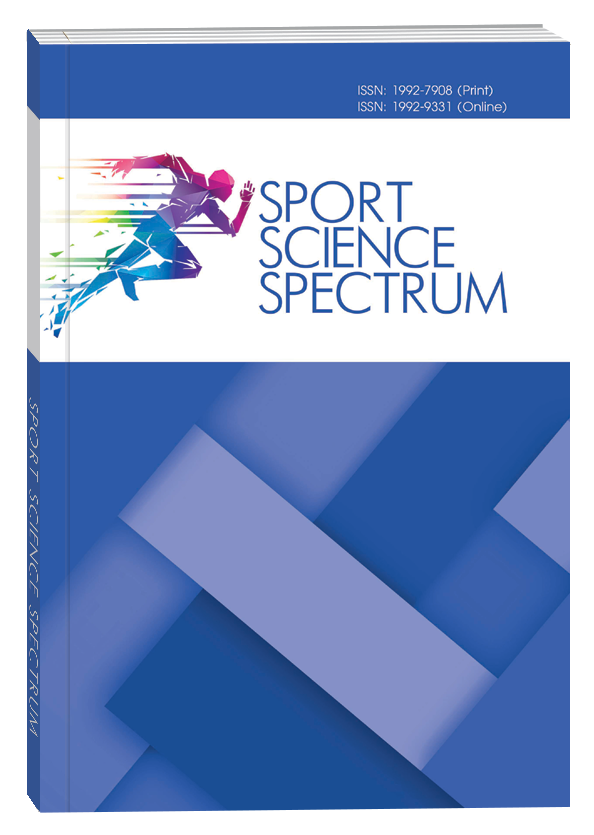INFLUENCE OF ATHLETE COMPATIBILITY ON THE EFFICIENCY OF TEAM INTERACTION IN ROWING
DOI:
https://doi.org/10.32782/spectrum/2024-1-6Keywords:
rowing, crew compatibility, psychological compatibility, functional compatibility, technical compatibility, morphological compatibility, teamwork, performance, principleAbstract
In the modern sports world, particularly in academic rowing, understanding and optimizing compatibility among team members and crews have gained significant importance. The increasing international competition and the constant pursuit of improving athletic performance drive the application of innovative training methods and a scientific approach to athlete preparation. The research aims to assess the impact of various compatibility aspects – functional, technical, psychological, and morphological – on the efficiency of interaction within academic rowing crews. Research methods. The research employed an analysis of specialized scientific literature, Internet data, practical experience, expert surveys, and mathematical statistical methods. Expert surveys of Ukrainian rowing coaches helped determine the significance of compatibility aspects in forming successful crews and how these aspects affect the overall team performance. A total of 25 experts participated in the study. Results. The research results indicate that functional (34 points) and technical (31 points) compatibility hold the highest significance for the success of academic rowing crews. Psychological compatibility (45 points) and athletes’ morphological characteristics (60 points) also play essential roles in team synergy formation. Additional data analysis revealed that movement synchronization, uniformity in technical skills, and athletes’ physical readiness directly influence race times and overall crew performance. Psychological resilience and adaptability positively correlated with the effectiveness of team interaction during competitions. Conclusion. The study confirms that a comprehensive approach to determining compatibility in academic rowing crews, which includes the assessment of psychological, functional, technical, and morphological aspects, is essential for enhancing teamwork effectiveness and achieving better athletic performance.
References
Дяченко А., Ван Ц. Сучасний стан і шляхи вдосконалення орієнтації підготовки юних кваліфікованих спортсменів у веслуванні на байдарках і каное. Спортивна наука та здоров’я людини. 2023. № 2 (10). С. 88–99. DOI: https://doi.org/10.28925/2664-2069.2023.27.
Федорчук С., Колосова О., Лисенко О., Шинкарук О. Взаємозалежність психо-фізіологічних та електронейроміографічних показників у кваліфікованих спортсменів-веслувальників. Спортивна медицина і фізична реабілітація. 2022. № 1. С. 33–41. DOI: https://doi.org/10.32652/spmed.2022.1.33-41/
Шинкарук О., Яковенко О., Коженкова А. Управління підготовкою спортсменів на основі моделювання та формування екіпажів у веслуванні академічному: монографія. Київ, 2021. 314 с.
Шинкарук О., Яковенко О., Коженкова А. Моделювання змагальної діяльності спортсменок у веслуванні академічному (на прикладі жіночої четвірки парної). Теоретико-методичні аспекти програмування та моделювання тренувального процесу спортсменів різної кваліфікації: колективна монографія. / за заг. ред. В. Костюкевича, О. Шинкарук. Вінниця: Твори, 2021. С. 177–190.
Anderson R., & Williams J. M. (2015). Coaching Science: Theory into Practice. Wiley-Blackwell.
Beilock S. L. (2010). Choke: What the Secrets of the Brain Reveal About Getting It Right When You Have To. New York: Free Press.
Bezmylov M., Shynkaruk O., Byshevets N., Gan Qi., Shao Zhigong. Morphofunctional characteristics of basketball players with different roles as selection criteria at the stage of preparation for higher achievements. Teorìâ ta Metodika Fìzičnogo Vihovannâ. 22 (1). 92–100. DOI: https://doi.org/10.17309/tmfv.2022.1.13.
Bezmylov M., Shynkaruk O., Griban G., Semeniv B., Yudenko O., Lytvynenko A., Otroshko O., Kholchenkova N., Kurtova H., Kostenko M., Osmanova A. Peculiarities of Physical Fitness of 17–20 Years Old Basketball Players Taking into Account Their Playing Role. International Journal of Human Movement and Sports Sciences, 10 (6): 1163–1172, 2022. DOI: 10.13189/saj.2022.100606.
Bishop D. (2016). Interpersonal Relationships in Sports Teams. International Journal of Sports Science & Coaching, 11 (4), 567–584.
Cox R.H. (2012). Sport Psychology: Concepts and Applications. 7th ed. New York: McGraw-Hill.
Fedorchuk S., Kolosova O., Lysenko O., Shynkaruk O. Psychophysiological and electromyographic indices in qualified rowers (kayaking / canoeing). EPA 2022 “Linking Clinical Practice and Research for Better Mental Health Care in Europe”. 30th European Congress of Psychiatry, 4–7 June 2022, Budapest, Hungary. EPV 1222. European Psychiatry, Vol. 65, Suppl. June 2022: S. 928.
Greenleaf C. (2017). The Impact of Morphological Compatibility on Success in Rowing. Journal of Rowing Research, 14 (1), 46–60.
Ieremenko N., Shynkaruk O., Moseychuk Yu., Moroz O, Ivashchenko O., Yarmak O., Andrieieva O., Galan Ya. Analysis of Main Ergometric Parameters of Elite Kayak Athletes Specialized in Different Distance Events. Sport Mont 19 (2021) 2: 3–7. DOI: 10.26773/smj.210610.
Johnson D.W., & Johnson F.P. (2005). Joining Together: Group Theory and Group Skills. 10th ed. Boston: Allyn and Bacon.
Larsen C. (2015). Success Factors in Team Sports: Analyzing Compatibility. Scandinavian Journal of Sports Studies, 7 (2), 120–135.
Murray G. (2011). Team Dynamics in Sports: Strategies for Success. Journal of Sports Psychology, 29 (5), 513–530.
Shao, Z., Bezmylov, M.M. & Shynkaruk, O.A. Individual characteristics of physical and mental development and their connection with regular physical exercises when playing basketball. Curr Psychol (2022). DOI: https://doi.org/10.1007/s12144-022-03692-w.
Shynkaruk O., Kostiukevych V., Mitova O., Griban G., Adyrkhaiev S., Adyrkhaieva L., Kozeruk Yu., Semeniv B., Zhlob T., Bakatov V., Hres M. Monitoring the Functional Status of Highly Qualified Canoeing Female Athletes in the Training Process for Intensive Competitive Activities International Journal of Human Movement and Sports Sciences. 10 (5): 1030–1039, 2022. URL: http://www.hrpub.org. DOI: 10.13189/saj.2022.100521.
Silva J., & Weiss M. (2013). Psychology of Sport and Exercise. 3rd Edition. New York: Springer.
Smith J. (1990). Team Dynamics and Psychological Factors in Sports. New York: Academic Press.
Takahashi Y., Okada A., & Miyagi T. (2004). The Impact of Social Compatibility on Team Performance in Sports. Journal of Sports Sciences, 22 (5), 435–442.
Weinberg R.S., & Gould D. (2014). Foundations of Sport and Exercise Psychology. 6th ed. Champaign, IL: Human Kinetics.
Williams J.M., & Logan A. (2003). Sports Psychology: Techniques for Coaches and Athletes. London: Routledge.
Xiang-Qian X., Korobeinikova L., Xu Li, Mischuk D., Korobeynikov G., Wei H., & Sergienko U. (2023). Formation of the structure of psychophysiological features of elite basketball players. Slobozhanskyi Herald of Science and Sport, 27 (3), 153–157. DOI: https://doi.org/10.15391/snsv.2023-3.006.





